Hours: Thurs-Mon, noon-6 pm
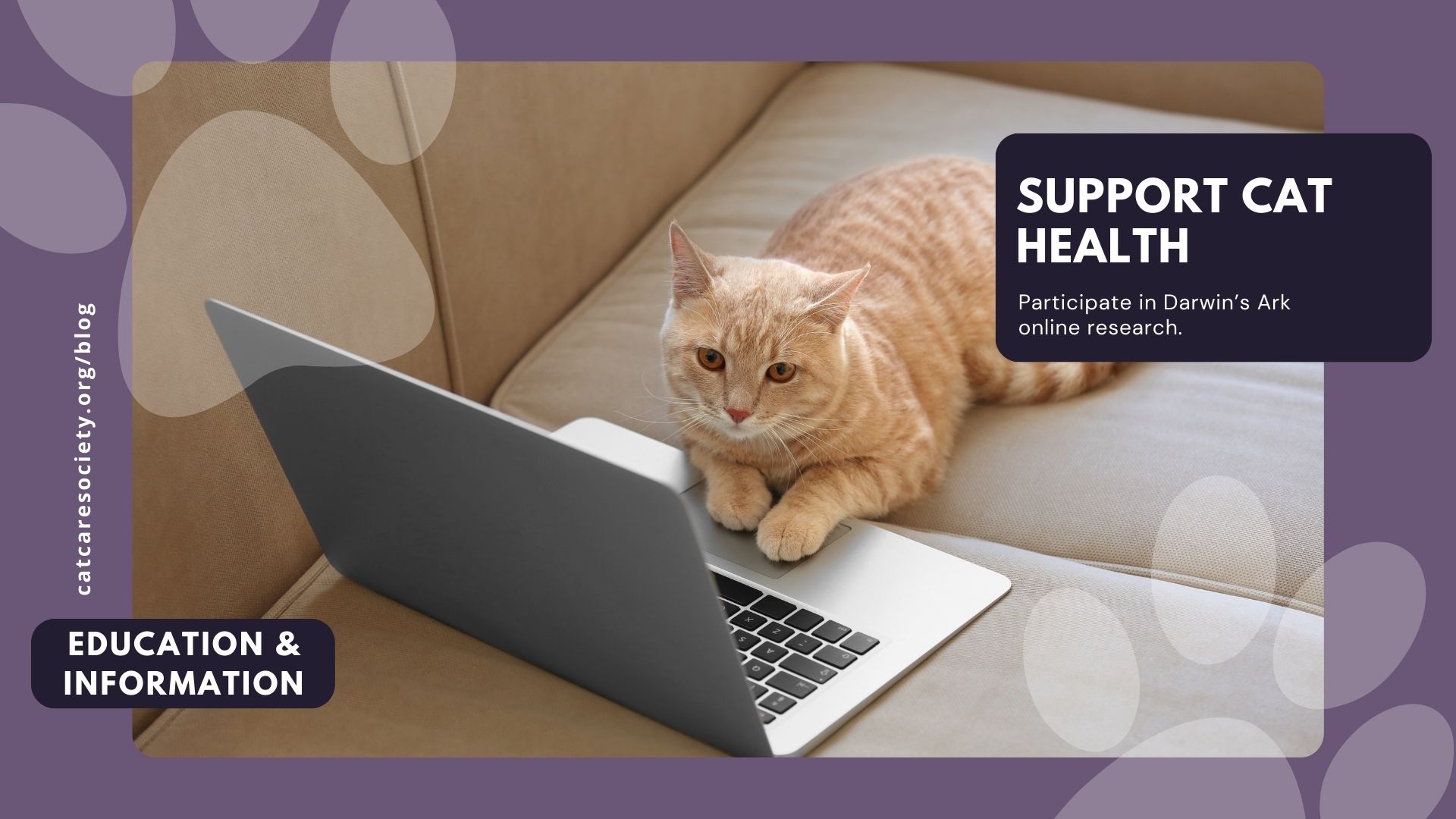
Let’s be honest—if you’re reading this, we probably don’t need to tell you how much joy cats bring into our lives. You already know the comfort of a purring cat in your lap, the entertainment of zoomies, and the simple calm of a cat sunbathing in a window. Cats are family.
But even though they’ve stolen our hearts (and our favorite spots on the couch), there’s still so much we don’t understand about their health. That’s where research comes in—and your participation can help in uncovering the mysteries behind feline wellness.
The health and wellbeing of cats often get overlooked in comparison to other pets like dogs. While research into canine health has flourished over the years, we’re only beginning to scratch the surface (pun intended) when it comes to understanding the unique needs and medical conditions of cats. From chronic illnesses like feline diabetes and kidney disease to behavioral issues such as anxiety and aggression, there are still many unanswered questions about what causes these conditions and how to best treat them.
To improve the lives of cats everywhere, we need more research. By deepening our understanding of how cats experience illness, aging, and stress, we can develop better treatments, prevention strategies, and care—helping them live longer, healthier, and happier lives.
One exciting initiative that aims to fill this gap in feline research is Darwin’s Ark, an online platform started by two pet lovers, a geneticist and an engineer, to advance scientific understanding of pet health. The website is an invaluable resource for anyone passionate about improving the lives of both dogs and cats through data-driven research.
For our purposes, we’re focusing on cat health, and at its core, Darwin’s Ark is about collecting and analyzing data from real cats living in homes, shelters, and other environments. The goal is to create a comprehensive database that researchers can use to study genetic and environmental factors that influence cat health. By gathering data on everything from a cat’s breed and genetic makeup to its medical history and behaviors, Darwin’s Ark provides vital insights that can shape future research.
The beauty of Darwin’s Ark is that it allows cat owners and shelters alike to play an active role in research. By participating in the program, you’re contributing valuable information that could lead to breakthroughs in veterinary science. Here’s how you can get involved:
The research conducted through Darwin’s Ark has the potential to change the way we think about feline health. By looking at the genetic and environmental factors that influence cats’ lives, researchers can gain a better understanding of how diseases like cancer, heart disease, and even infectious illnesses develop in cats. This information will help veterinarians make more accurate diagnoses, prescribe better treatments, and ultimately improve the lives of cats.
But it’s not just about medical conditions. Research into feline behavior and mental health is equally important. Many cats suffer from anxiety, depression, or stress, often due to changes in their environment, lack of stimulation, or inadequate socialization. By understanding the root causes of these behavioral issues, we can develop strategies to create happier, more well-adjusted cats who can thrive in their homes.
Additionally, shelters can use the findings from these studies to provide better care for cats in their care. Whether it’s understanding how to better treat sick cats, providing more enrichment opportunities, or improving the adoption process, data-driven research will help shelters give cats the best possible chance at a healthy and fulfilling life.
In the grand scheme of things, supporting research into feline health is about more than just helping individual cats—it’s about ensuring that all cats, everywhere, can live longer, healthier lives. The more we know, the better we can protect and care for our kitty companions, whether they’re our beloved pets at home or shelter cats.
For more information or to get started, visit Darwin’s Ark today and be sure to check out their fascinating blog article on why cats are so understudied. By supporting platforms like Darwin’s Ark, we take a step toward making a tangible difference in the lives of cats, promoting better health outcomes, and advancing our understanding of these extraordinary animals. Every small contribution counts—whether it’s participating in research, sharing the word, or making a donation. Let’s work together to ensure that all cats can live their best lives.
About the Author: Beth Dokolasa is a volunteer for Cat Care Society and serves on the Board of Directors. She is an instructional developer for Natural Grocers and lives in Indian Hills, Colo., with her husband, daughter, and two cats, Techno and Digit.
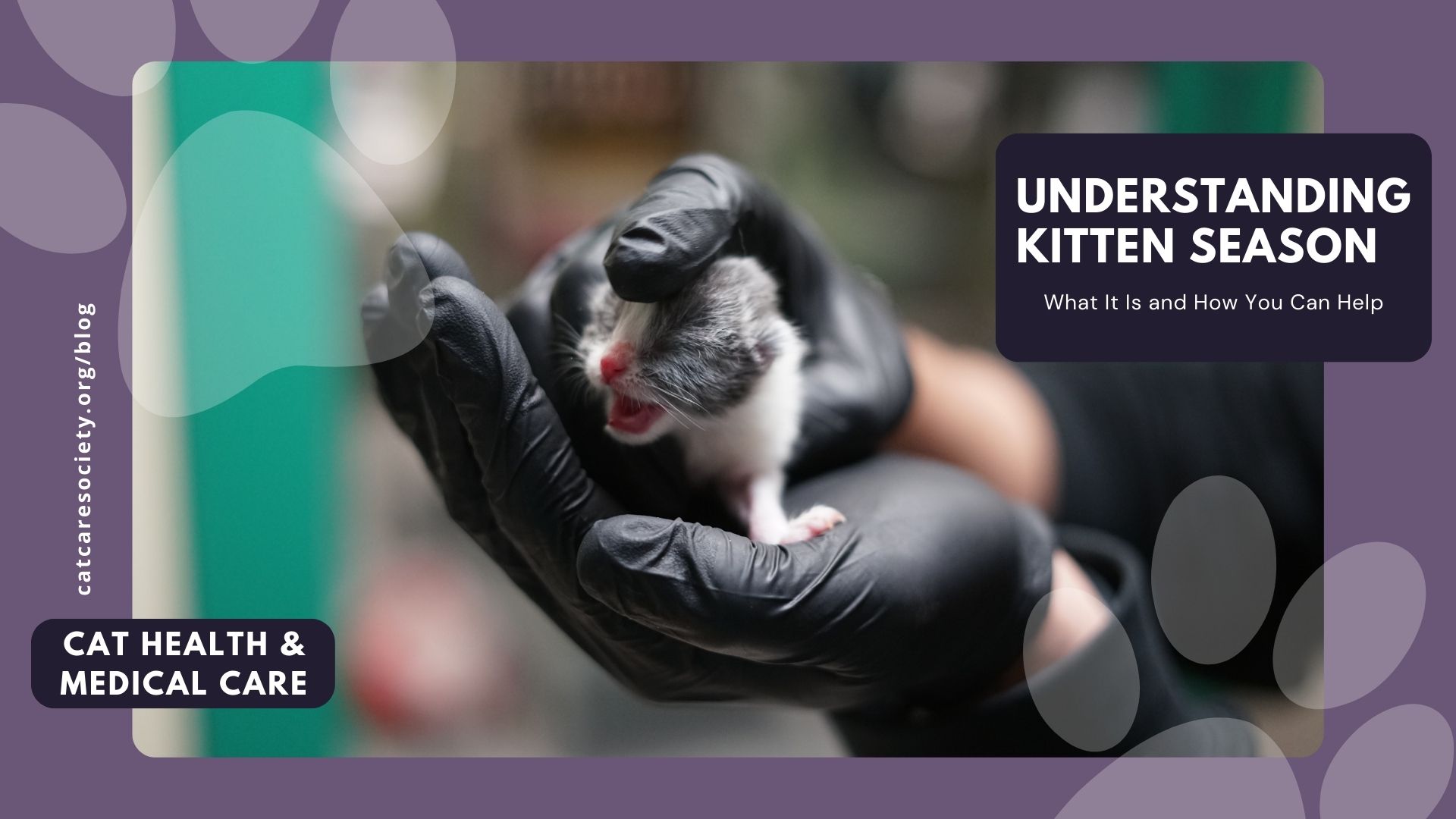
If you love cats, you may have heard the term “kitten season” before—but what exactly does it mean? Kitten season is the time of year when shelters and rescues typically receive an influx of newborn kitten litters as well as their mothers. This surge in cats can create challenges for pet shelters, but with the right knowledge and support, everyone can play a part in helping shelters, ensuring the well-being of the cats, and finding them a loving home.
Kitten season typically occurs from early spring through late fall, with a peak in the warmer months. During this time, unspayed female cats go into heat more frequently and have the potential to give birth to multiple litters, with an average of 4-6 kittens born per litter. This can really add up! Many of these kittens are born outdoors to feral or stray cats and end up in shelters or on the streets.
While kittens are undeniably adorable, the large number arriving at shelters during kitten season creates a high demand for resources like medical care, food, and space. In Colorado, kittens cannot be adopted until they are two months old so shelters are providing lots of long term care for them! Shelters and rescue organizations work tirelessly to care for these kittens and their mothers, but they often face challenges like overcrowding and foster home shortages.
Foster homes help address space shortages but they also play a crucial role in keeping all cats healthy. Kittens don’t yet have a fully developed immune system or GI tract making them more vulnerable to catching and spreading illnesses, which can further overwhelm the shelter and impact other cats. Kittens do not begin to receive illness preventing vaccines until they are at least four weeks of age. Additionally, kittens require frequent monitoring, socialization, and specialized care, which can be challenging for shelters managing many animals at once. Foster caregivers help by providing individualized attention, ensuring kittens receive the care they need to grow strong and healthy before adoption.
To reduce the number of kittens in shelters and ease the ongoing pressure on resources, shelters also focus on spaying mother cats, preventing future litters. This helps break the cycle of overcrowding and ensures that shelters can better meet the needs of all the cats in their care. With community support—through fostering, adoption, and other forms of assistance—we can give every kitten the best chance at a healthy, happy future.
There are many ways you can make a difference during kitten season. Whether you’re able to adopt, foster, volunteer, or support from afar, every effort counts. Here are some suggestions:
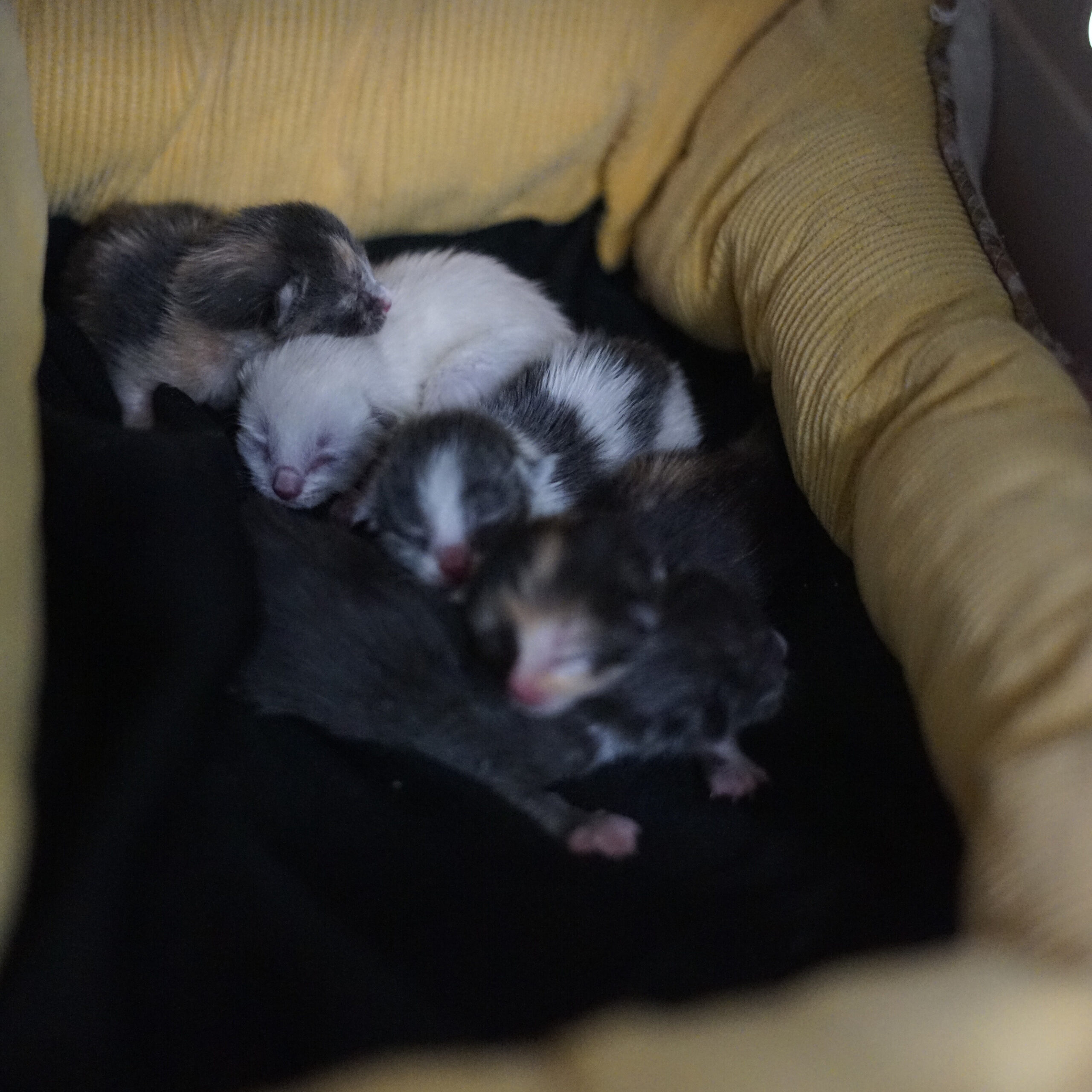
Many shelters and rescues rely on foster homes to care for young kittens
who are too small to be adopted. These kittens need a safe and loving environment where they can grow, socialize, and receive proper medical care. Fostering is a rewarding experience and saves countless lives. Learn more about being a foster with Cat Care Society and apply online.
Preventing unwanted litters starts with responsible pet ownership. Ensure your own cats are spayed or neutered, and encourage friends and family to do the same. We have a resource list of lost-cost clinics that can help make this more accessible. Encourage your friends and family to read more about the benefits of spaying and neutering your cats in one of our other blog posts.
If you’ve been thinking about welcoming a cat into your family, kitten season is an ideal time to adopt. Shelters are overflowing with kittens and adult cats looking for homes. We also suggest adopting two kittens at the same time so they can continue practicing great behavior habits! By adopting, you’re not only giving a cat a second chance but also freeing up space in shelters for other animals in need. Check out our cats available for adoption!
Cat Care Society has a robust in-house cat socialization and enrichment program, and we also have many great resources to help you bond with your new kitty once it’s home and set up an environment where your cat can play, express their natural behaviors, and thrive!
One of the most effective ways to reduce the number of kittens born on the streets is through Trap-Neuter-Return (TNR). This humane approach involves trapping stray and feral cats, having them spayed or neutered, and then returning them to their outdoor colonies where they have adapted to live. TNR helps stabilize cat populations and prevents future litters from being born. Read more about TNR in one of our other blog posts and check out our list of TNR organizations that provide services in the Denver metro area if you’d like to get involved or need support.
Whether or not you can adopt or foster, there are plenty of ways to make a difference! Here are just a few ways you can help:
EduCATion is key to supporting our cat population—it’s built right into the word! Share information about kitten season, TNR programs, and responsible pet ownership with your community. Social media, local events, and word-of-mouth can all help raise awareness and encourage others to get involved.
Follow us on Instagram, Facebook, and TikTok for helpful, shareable content. Sign up for our email newsletter, aka our Mewsletter, to stay updated on upcoming events, adoptable cats, must-read stories, and ways to support the shelter. We also publish a quarterly print newsletter called Cat Care Quarterly that you can sign up to receive at home for free!
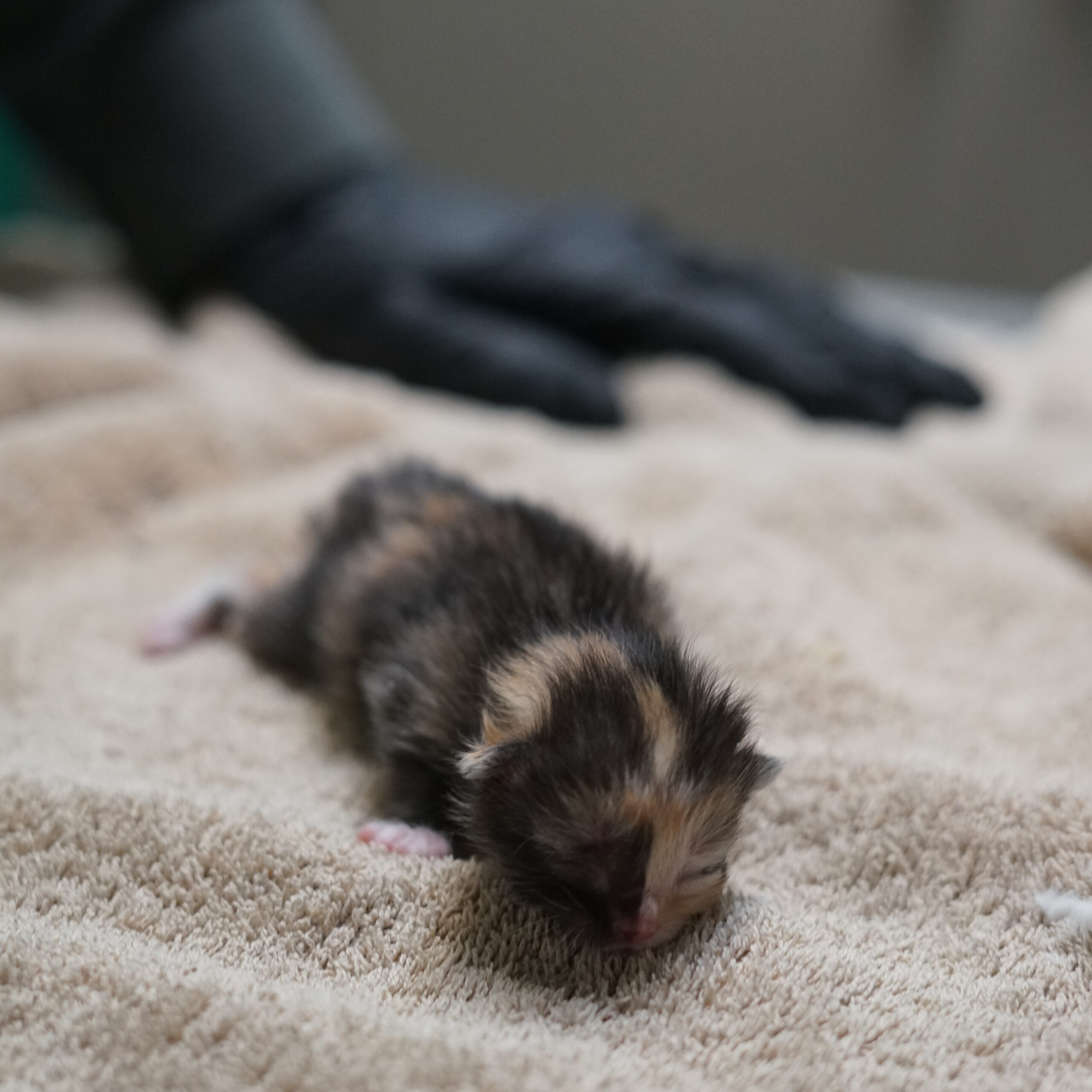
Kitten season is a challenging time for shelters and rescues, but with community involvement, we can help save lives and reduce the number of homeless cats and overcrowded shelters. Whether you open your home to a cat in need, contribute supplies or funds, or simply spread the word, your support makes a meaningful impact. CCS is grateful to all of our supporters, including our dedicated volunteers, fosters, donors, adopters and beyond. Let’s continue working together to give kittens the best start in life and create a brighter, more hopeful future for all cats!
About the Author: Beth Dokolasa is a volunteer for Cat Care Society and served on the organization’s junior board. She is an instructional developer for Natural Grocers and lives in Indian Hills, Colo., with her husband, daughter, and two cats, Techno and Digit.
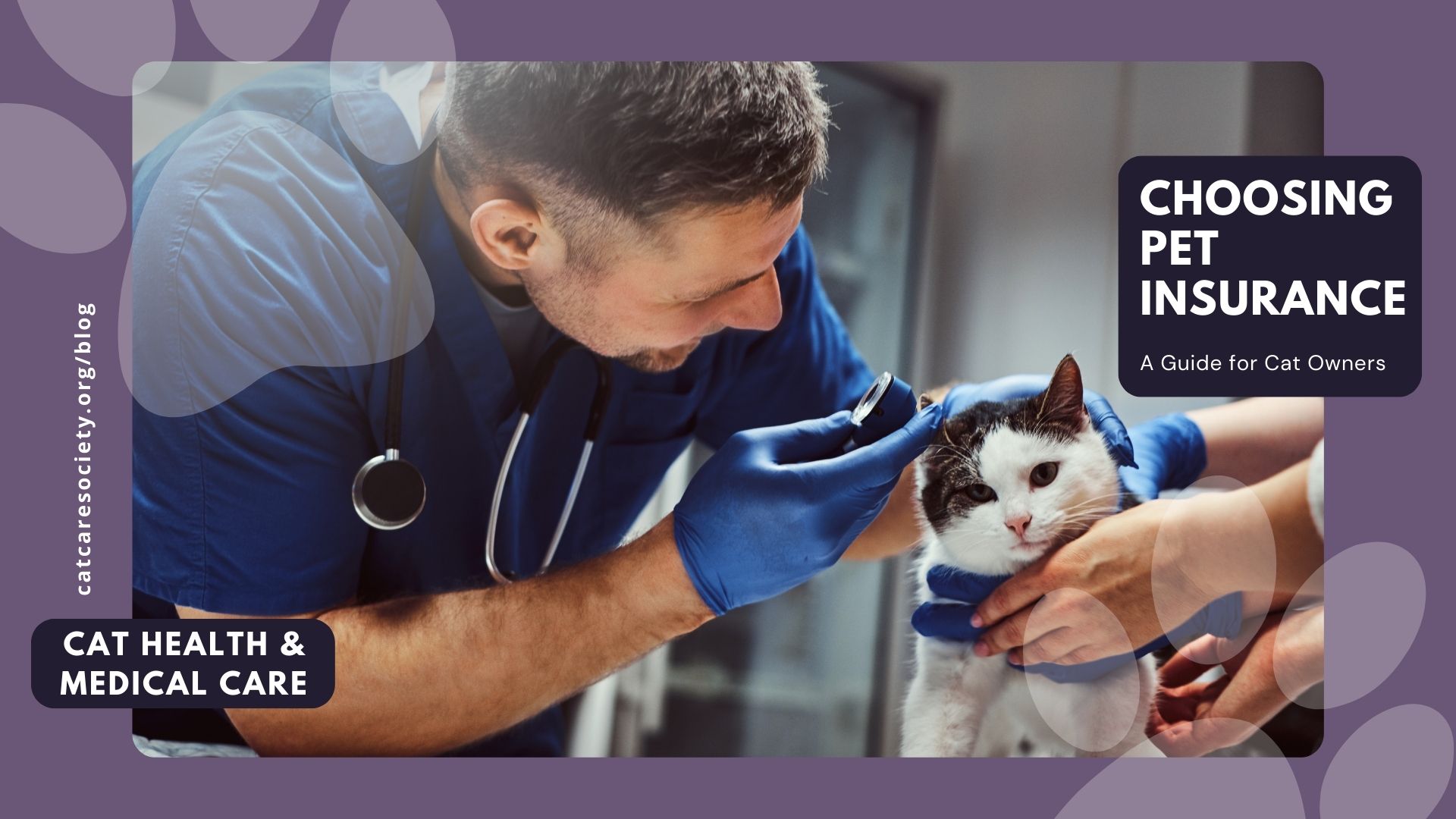
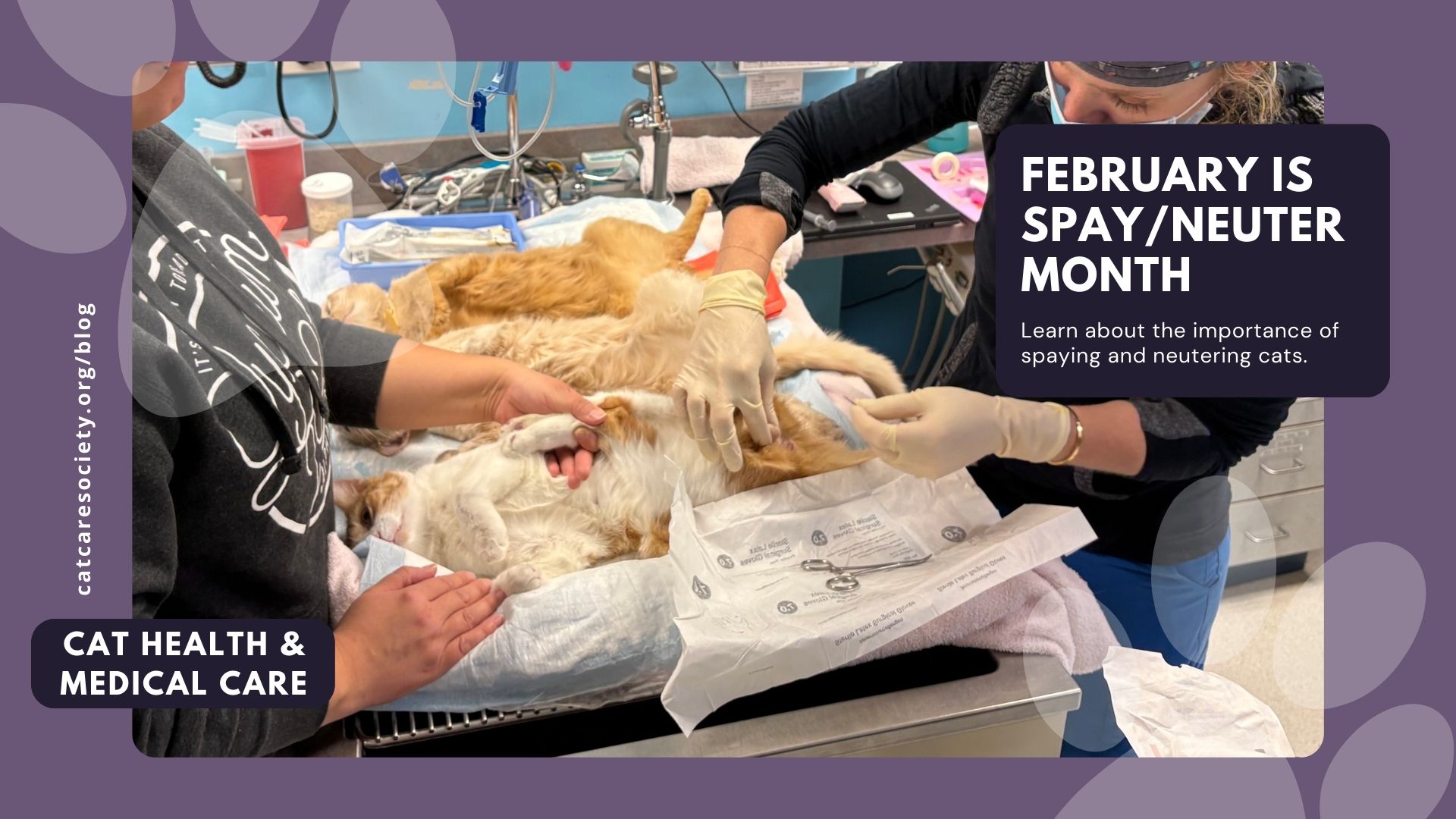
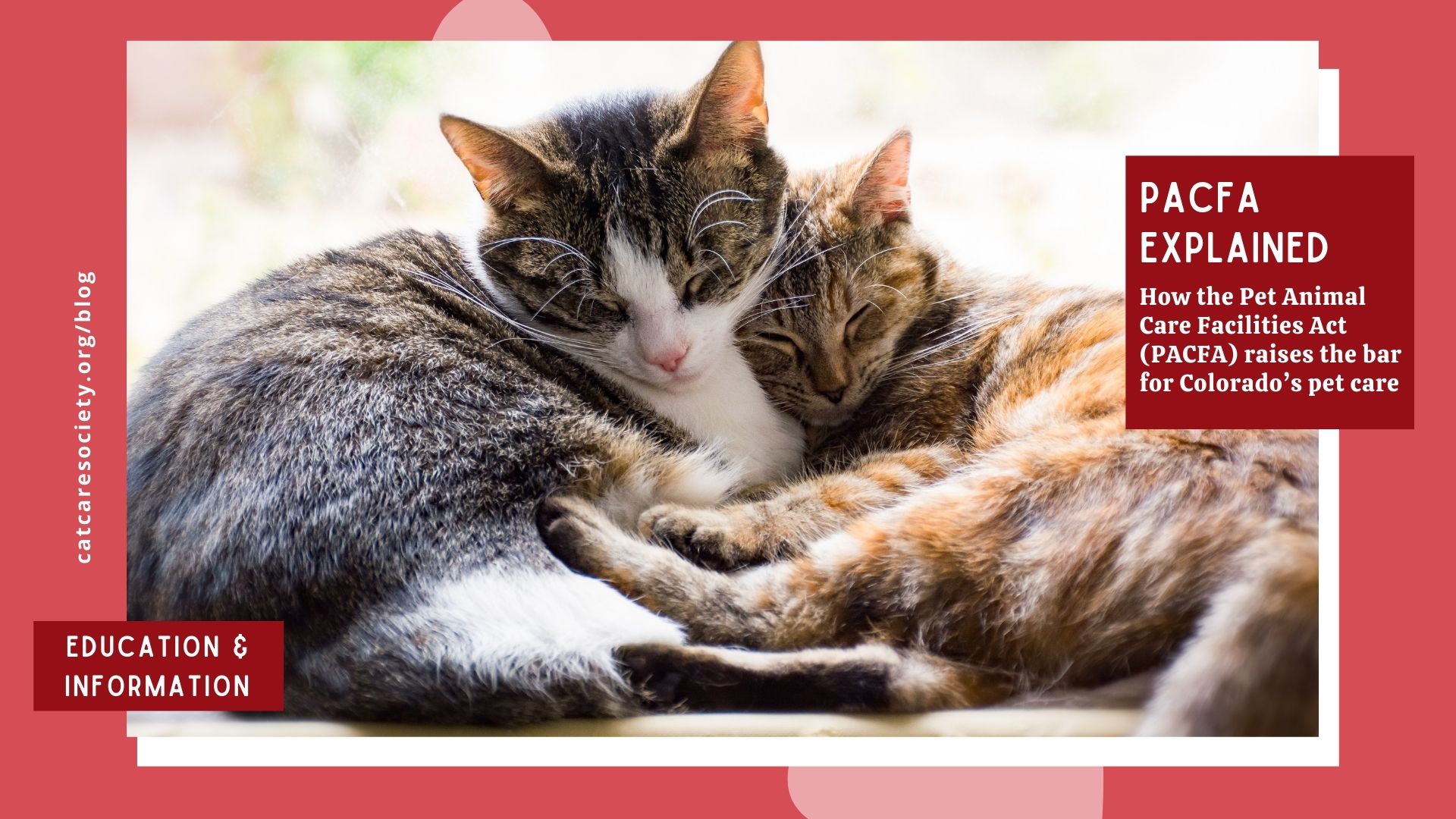
In Colorado, caring for animals isn’t just a calling—it’s a fundamental responsibility governed by the Pet Animal Care Facilities Act (PACFA). Established in 1994, this program protects the health, safety, and welfare of animals in pet care facilities while also protecting consumers who utilize pet-related services.
Whether someone runs an animal shelter (like we do at Cat Care Society!), a pet grooming business, a breeding operation, or a rescue, PACFA requires a license to legally care for animals. This state law sets comprehensive standards to ensure that animals in licensed facilities receive proper care. Through regular updates and inspections, PACFA prioritizes animal welfare, positioning Colorado as a leader in this field. In this article, we’ll explore the broad and comprehensive scope of PACFA, clarify what it doesn’t cover, and explain why it matters for pets and pet owners across Colorado.
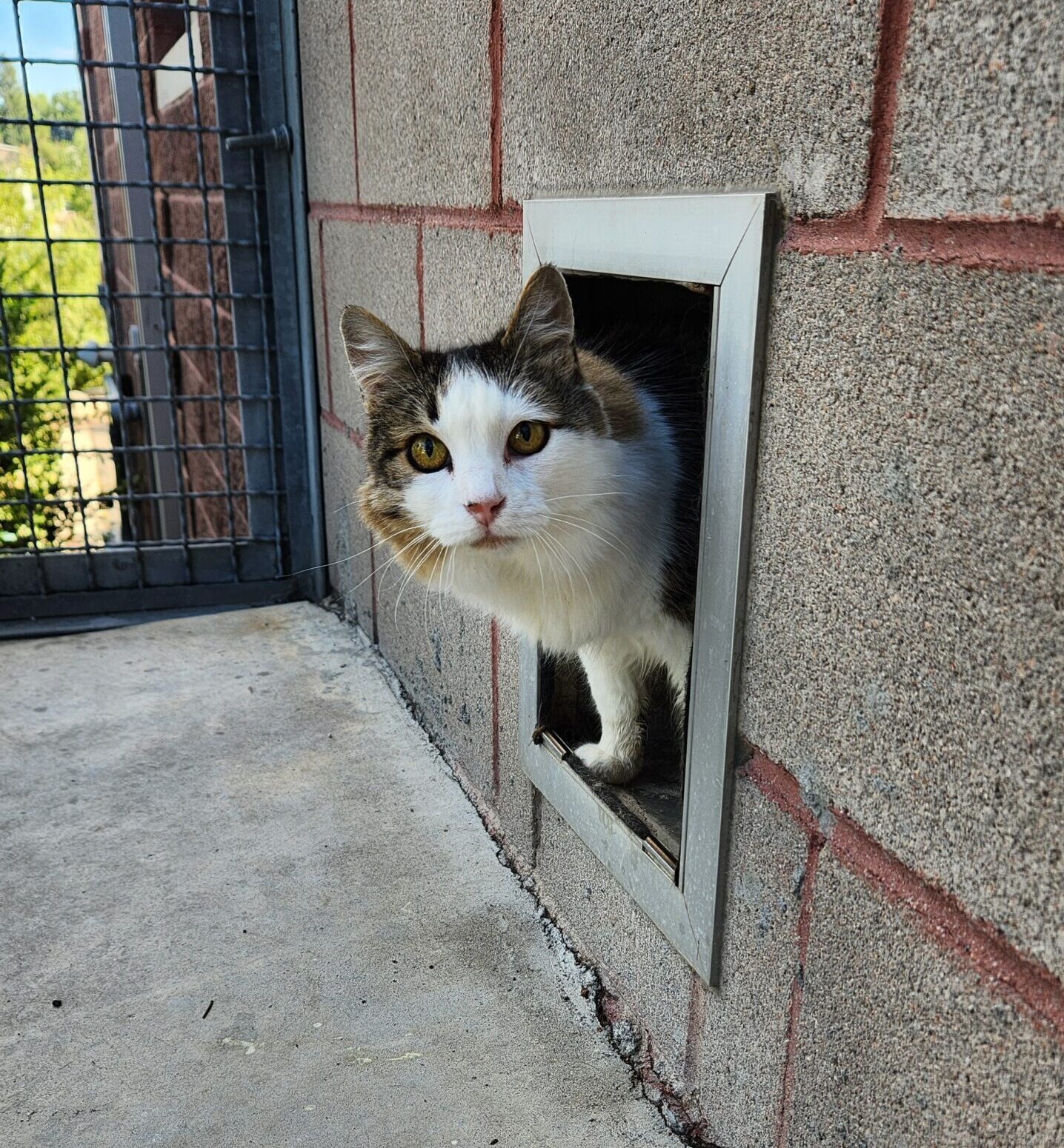
PACFA is Colorado’s state law that regulates companion animal care facilities, ensuring animals receive proper treatment and live in environments where their physical and emotional needs are met. Some animals covered under PACFA include cats, dogs, birds, guinea pigs, mice, rats, hamsters, gerbils, ferrets, rabbits, reptiles, amphibians, and fish.
One of the strongest aspects of PACFA is its comprehensiveness and level of detail. Below are just some of the areas it covers. Note that requirements are individualized based on animal type.
The Colorado Department of Agriculture (CDA) is responsible for enforcing PACFA regulations. This oversight ensures that any organization involved in pet care operates with transparency, accountability, and a deep commitment to the animals in their charge. To earn and maintain a PACFA license, facilities like shelters, rescues, pet stores, and groomers must pass rigorous inspections, meet specific criteria on an ongoing basis, and complete annual reporting.
PACFA’s licensing program isn’t just about paperwork—it’s about safeguarding animal welfare. By maintaining a PACFA license, facilities commit to meeting essential standards for animal housing, health, and safety, all under the enforcement of the CDA. And as these standards are regularly updated, shelters and rescues must stay current, adapting to new regulations that reflect the evolving practices in animal care. Additionally, current PACFA licensees must complete a qualifying continued education every two years to stay up-to-date with PACFA’s standards.
While the terms shelter, rescue, and sanctuary are often used interchangeably, the Colorado Department of Agriculture provides distinct legal definitions for each. The Rules and Regulations Pertaining to the Administration and Enforcement of the Pet Animal Care and Facilities Act (8 CCR 1201-11) specify the classifications for various types of animal facilities. At Cat Care Society (CCS), we operate as a private non-profit animal shelter and do not receive any government funding.
PACFA isn’t animal control or animal protection. Municipal animal control units enforce municipal and state ordinances typically related to private citizen pet ownership, such as dog licensing, leash laws, lost and found, and cruelty/neglect. However, PACFA staff may partner with a local animal control unit if animal cruelty and neglect is discovered.
Additionally, PACFA is required by the state to report animal cruelty and neglect to local law enforcement or the Colorado Bureau of Animal Protection (BAP). BAP conducts outreach and education to prevent neglect and mistreatment of domestic and companion animals in Colorado and follow-up on complaints to help enforce pertinent laws.
PACFA doesn’t oversee licensure of veterinarians or vet techs. The State Board of Veterinary Medicine within Colorado’s Department of Regulatory Medicine regulates and licenses/registers veterinarians and veterinary technicians in the State of Colorado.
Since 1981 Cat Care Society has been committed to a very simple mission: provide cats with the best possible care until they find their forever homes. We fully comply with PACFA’s standards, and our commitment to evolving with the research behind these regulations reflects our ongoing dedication to providing the best possible care for the cats we serve. But we don’t stop there. We believe every cat deserves a safe, loving environment, regardless of age or medical condition.
From individualized care plans to behavioral enrichment programs and our exceptional volunteer and foster teams, we strive to exceed PACFA’s requirements to make sure each cat is living its best life. That includes having a free-roaming environment for our cats and going above and beyond in evaluating older and special-needs cats to determine the best course of treatment and care.
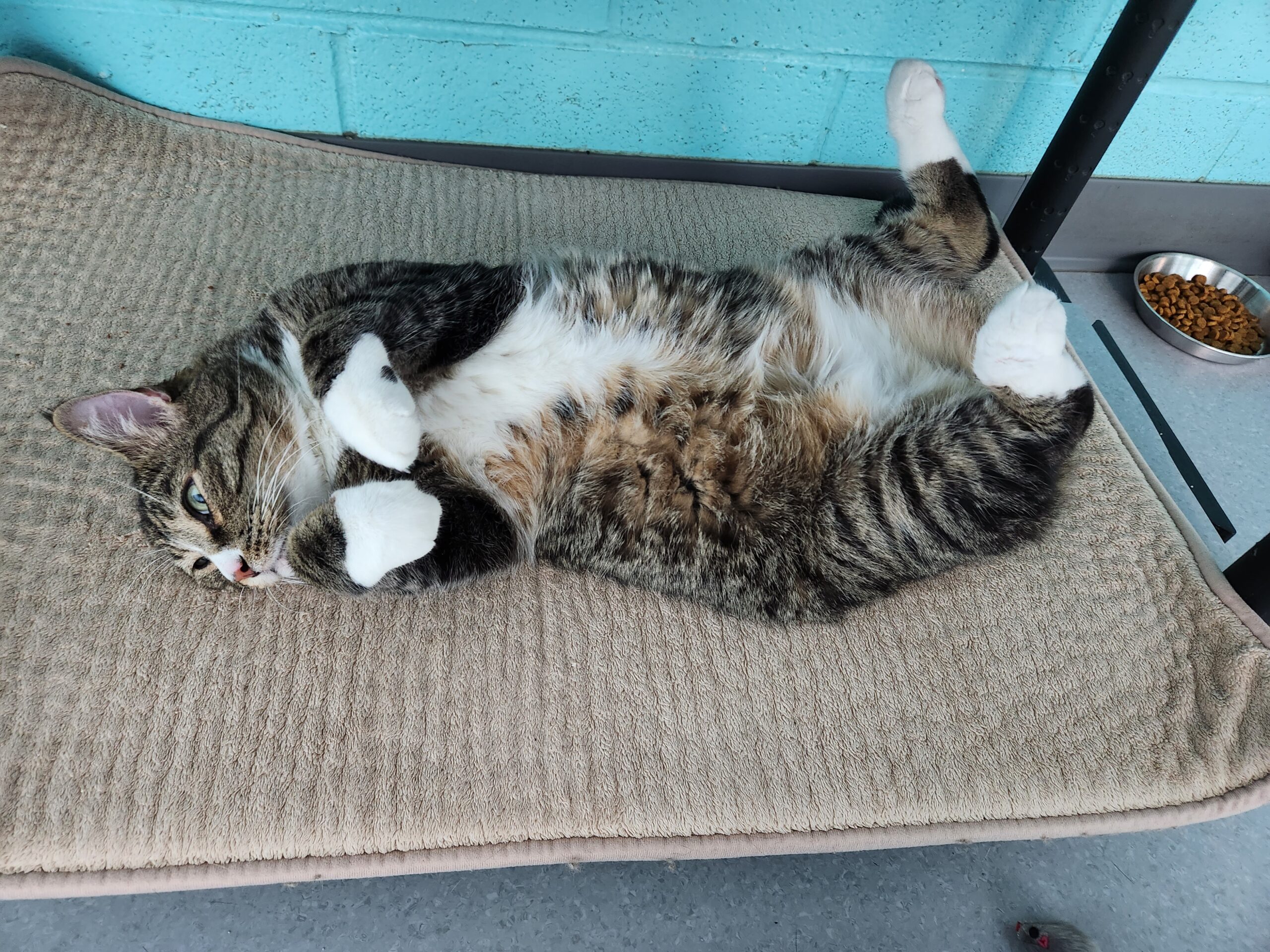
PACFA isn’t just about enforcing rules—it’s about creating a culture of responsibility and compassion across the entire pet care field. By ensuring that everyone in the business of caring for animals meets high standards, PACFA guarantees that every cherished pet gets the attention, safety, and love they deserve.
And at Cat Care Society, we’re all about love—our love for cats and our dedication to upholding the values that PACFA instills. Together, with PACFA’s guidance, we’ll continue to make Colorado a better, safer place for animals, one purr at a time.
We want all animals to be treated with respect and care which is why we encourage you to reference the PACFA Active Facilities List when selecting a pet care service. The CDA also provides detailed information on their website including data, FAQs, and of course, the full PACFA legislation. Here at CCS, we’re committed to transparency, so on our About Us page, you can find details about how we care for our cats, our latest impact report, our strategic plan, and much more! We also offer an extensive list of recommended pet service providers on our Resources page.
About the Author: Beth Dokolasa is a volunteer for Cat Care Society and serves on the Board of Directors. She is an instructional developer for Natural Grocers and lives in Indian Hills, Colo., with her husband, daughter, and two cats, Techno and Digit.

Winter, with its short days and chilly weather, often confines us indoors, making it the perfect season to enjoy the warmth and company of a cat. A field of study known as zooeyia (pronounced zoo-AY-uh) explores the positive impact of human-animal interactions on health, including physical, mental and emotional health. Meaning a cat isn’t just comforting a cozy companion during the colder months, but you share a beneficial, lifelong bond. In this article, we’ll explore the many health benefits to sharing your home with a cat. We’ll also provide some fun activities to enjoy with your cat during a cozy snow day.
Derived from the Greek word for “animal” (zoion) and “health” (Hygeia, the ancient Greek goddess of health), zooeyia encompasses the wide-ranging physical, emotional, and social benefits of owning pets. Cats, as beloved companions, exemplify zooeyia by their ability to:
Combat winter monotony by getting creative with your cat! These activities not only enrich your pet’s life but also elevate your mood and strengthen the bond between you and your kitty.
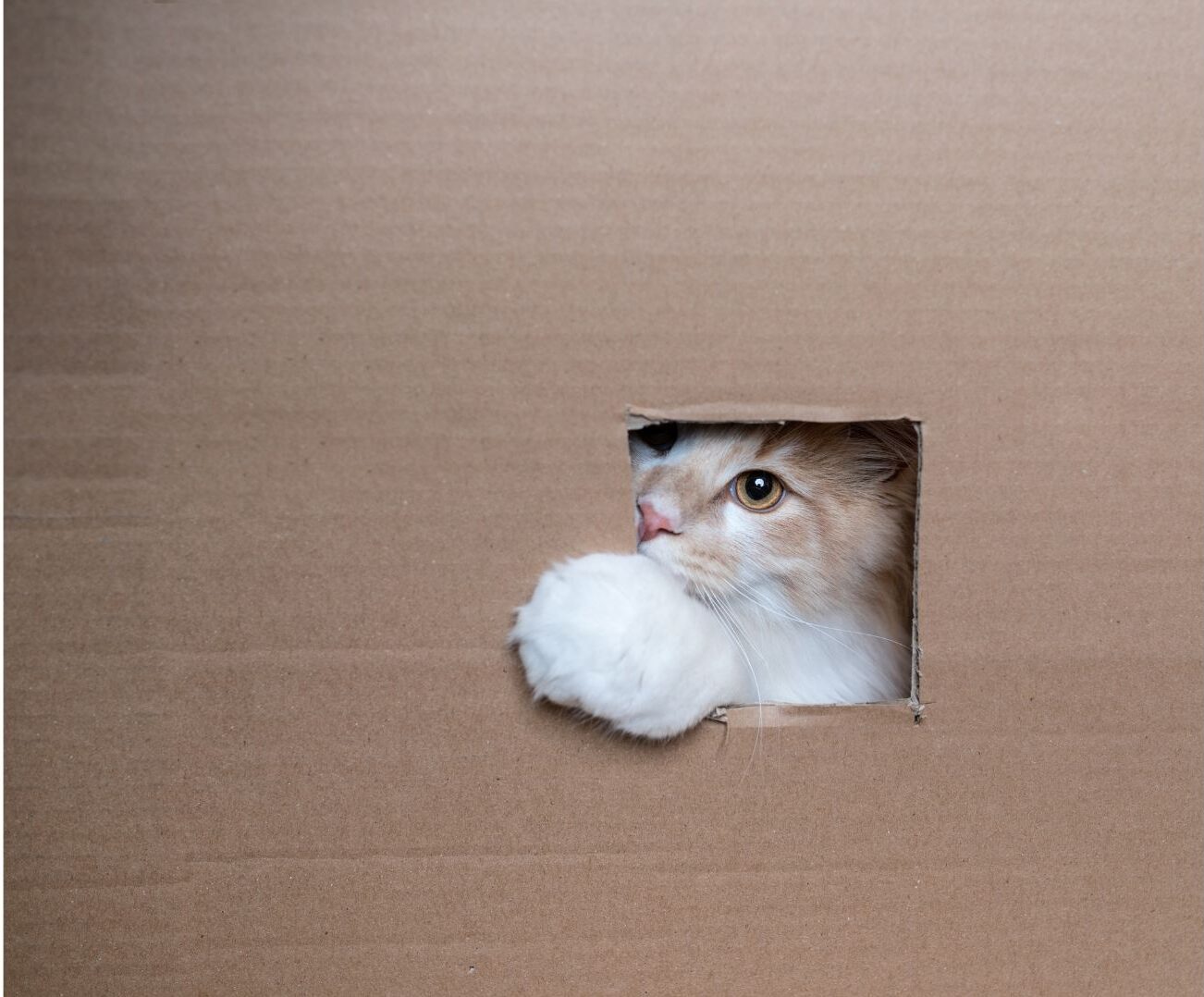
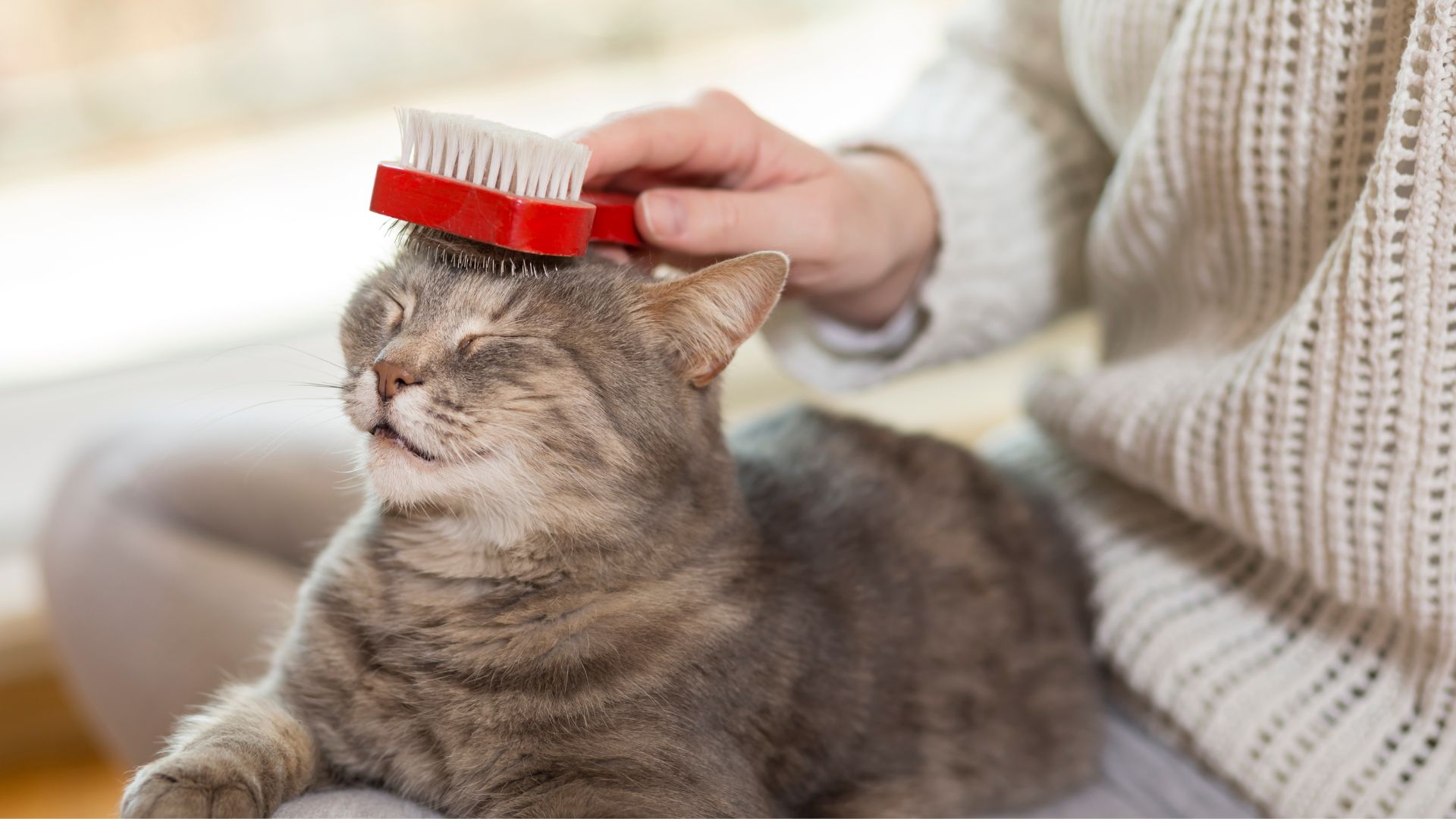
Note that some cats need breaks from physical touch. Read our blog post on overstimulation in cats to learn how to recognize the signs to ensure a positive experience.
Cats offer much more than companionship—they embody the principles of zooeyia by enhancing our mental and physical health, especially in challenging times like winter. Pairing these benefits with fun activities ensures both you and your cat stay happy and engaged. We always have cats available for adoption, so check them out if you’re ready to embrace the warmth and joy they bring to your home (or multiply it if you already have cats!).
About the Author: Beth Dokolasa is a volunteer for Cat Care Society and serves on the Board of Directors. She is an instructional developer for Natural Grocers and lives in Indian Hills, Colo., with her husband, daughter, and two cats, Techno and Digit.
Resources
Allen, K., Blascovich, J., & Mendes, W. (1998). Cardiovascular reactivity and the presence of pets, friends, and spouses: the truth about cats and dogs. International Journal of Psychophysiology, 30(1–2), 116. https://doi.org/10.1016/s0167-8760(98)90295-1
Anderson, K. L., & Olson, J. M. (2015). The value of a pet in enhancing the quality of life. The Journal of the American Board of Family Medicine, 28(4), 526–534. https://www.jabfm.org/content/28/4/526.long
McConnell, A. R., Brown, C. M., Shoda, T. M., Stayton, L. E., & Martin, C. E. (2011). Friends with benefits: On the positive consequences of pet ownership. Journal of Personality and Social Psychology, 101(6), 1239-1252. https://doi.org/10.1037/a0024506
Stammbach, K. B., & Turner, D. C. (1999). Understanding the Human—Cat Relationship: Human Social Support or Attachment. Anthrozoös, 12(3), 162–168. https://doi.org/10.2752/089279399787000237
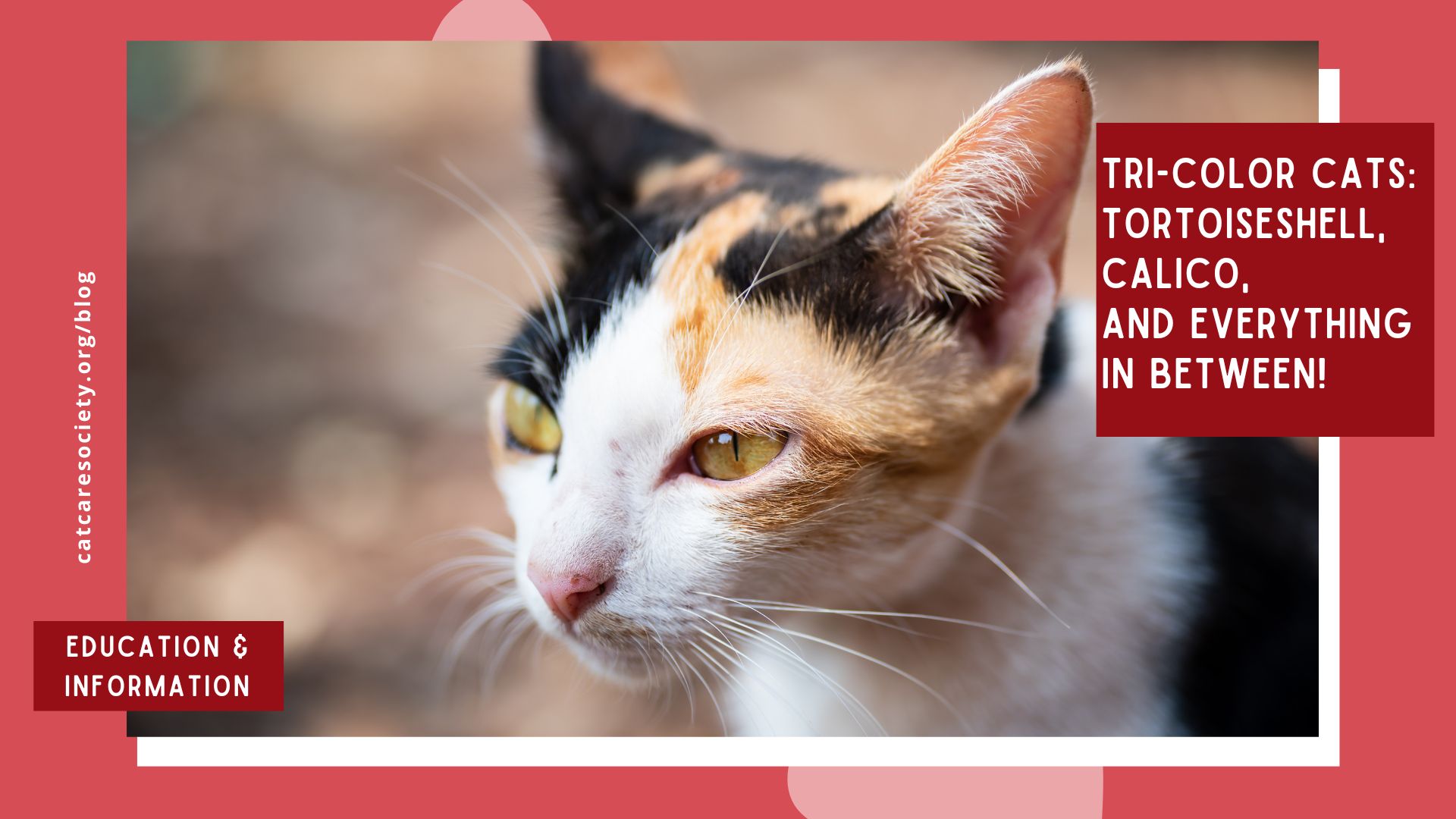
With Halloween approaching, it’s the perfect time to spotlight a particular type of cat—and no, we’re not talking about black cats! Instead, we’re focusing on tri-color cats, whose coats feature a mix of black, orange, and white in varying patterns and ratios. While “tri-color” and “calico” are often used interchangeably, calico cats have a distinct coat pattern. Tortoiseshell cats are also considered tri-color, even though they usually lack white and have their own unique pattern. It’s important to remember that “calico” and “tortoiseshell” refer to coat patterns, not breeds. These color combinations are the result of genetics and can appear in any breed, though they are more commonly found in breeds like American Shorthair, British Shorthair, Japanese Bobtail, Maine Coon, and Persian.
There are also diluted and tabby variations of tortoiseshell and calico cats—so many colorful kitties to love! In the rest of this article, we’ll explore the different markings and patterns that define each type of tri-color coat. By the end, you’ll be able to recognize the unique beauty of every tri-color cat you encounter.
Tri-color cats are almost always female, with approximately one in 3,000 being male. This is because two X chromosomes are needed to have a distinctive tri-color coat. Typically, if a cat has an XX pair, she will be female. Male cats have an XY chromosome pair, so they’re not tri-color unless they have at least one extra chromosome (XXY). Unfortunately, these males often suffer from Klinefelter’s Syndrome, a condition that can negatively affect their health and longevity.
Calico cat coats feature patches of solid orange, black, and white. The white color is a result of a genetic condition called piebalding, which occurs in a range of other domestic and farm animals. In a diluted calico, the colors are more muted to cream, gray, and white, due to a gene inherited from one of the parents that diminishes color intensity.
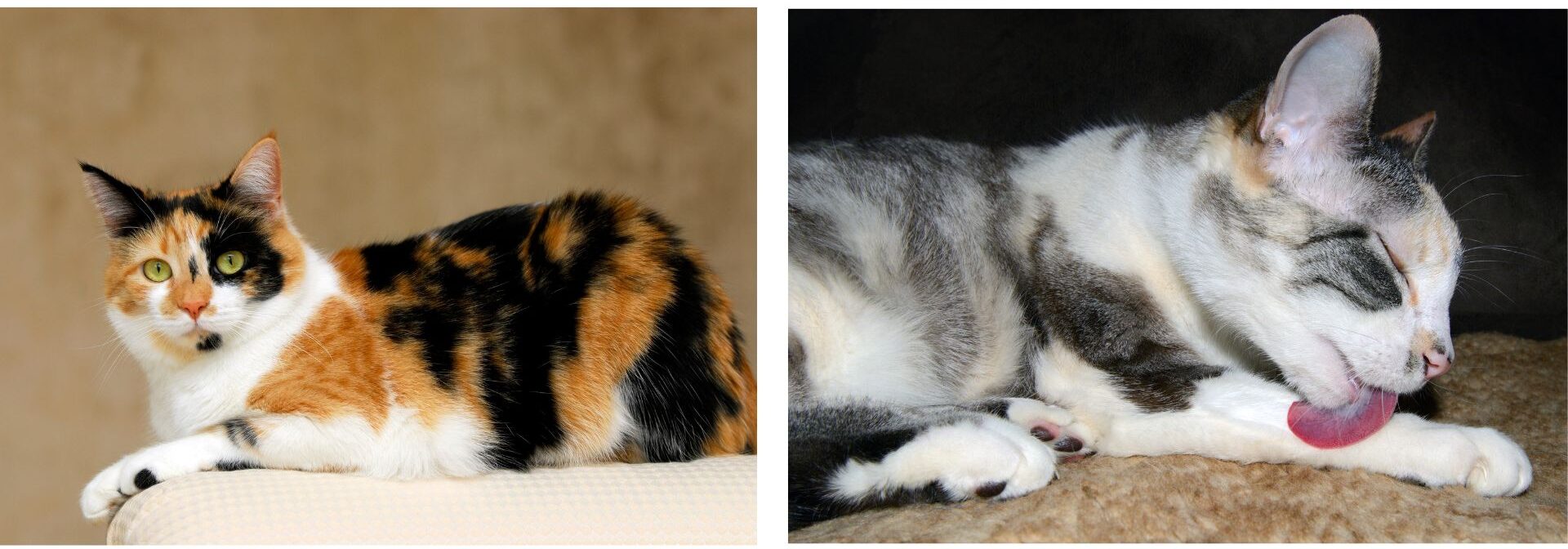
“Tabico” is a term for cats that have a combination of tabby and calico markings. These cats have large patches of orange and black on a white background, with tabby stripes overlaying some of the black and orange areas. When tabby stripes cover the forehead, they form the distinctive “tabby M.” A diluted tabico’s coat features cream, gray, and white fur.
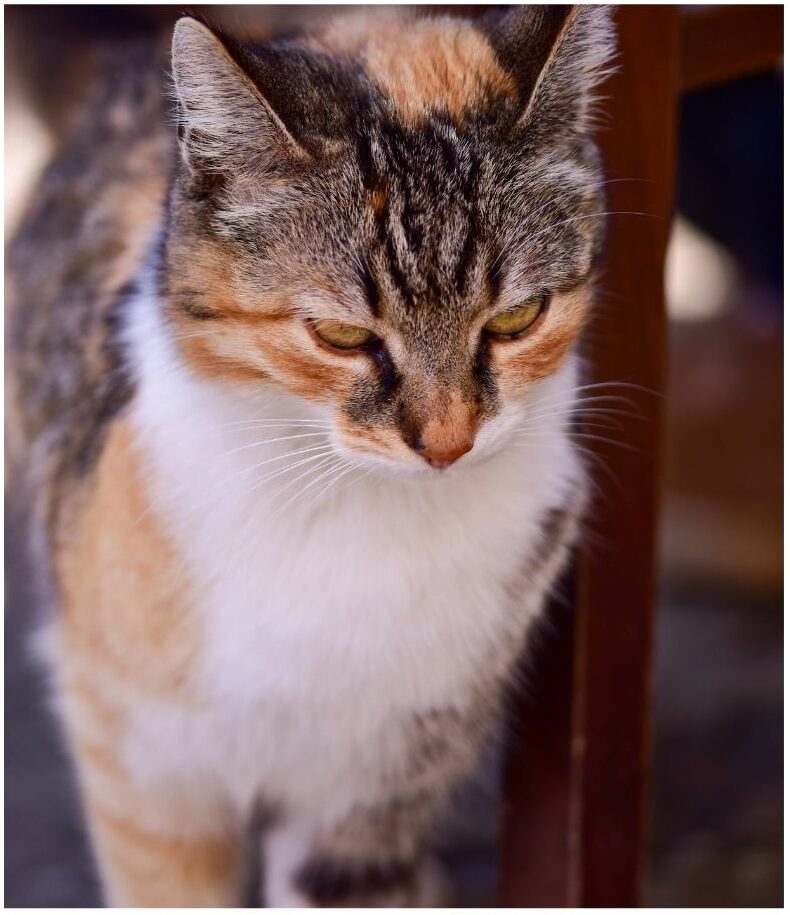
Tortoiseshell, or “tortie,” cats have brindle patterns (irregular stripes or streaks) of orange and black with little to no white. A diluted tortie has gray and cream colors and is a result of both parents carrying a recessive gene that impacts the intensity of the colors.
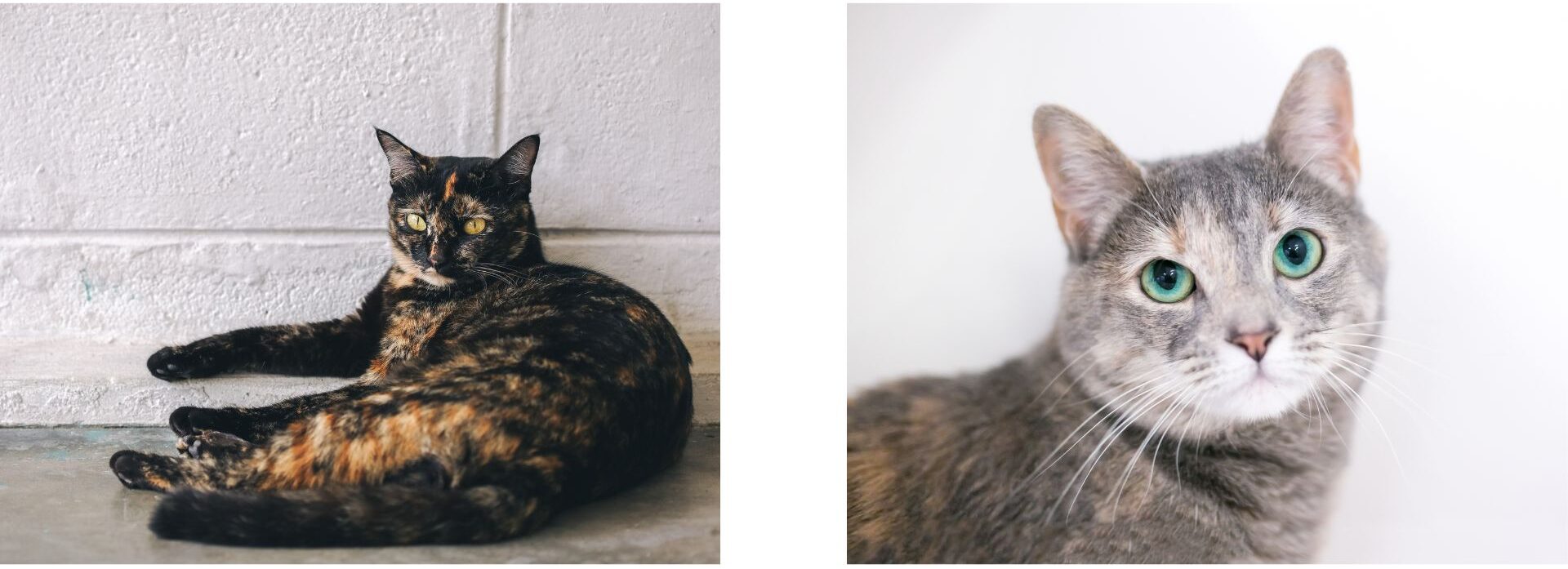
A torbie cat exhibits both the multi-colored brindle pattern of a tortoiseshell cat and the characteristic stripes or spots of a tabby. Like the tabico, if there are tabby stripes on the cat’s forehead, they will display the “tabby M.” Diluted torbies usually have a cream, gray and white coat.
A “tortico” is a combination of classic tortie and calico markings, featuring large patches of orange and black brindling on a white background. A diluted tortico is relatively rare, and will be gray and cream, and white.
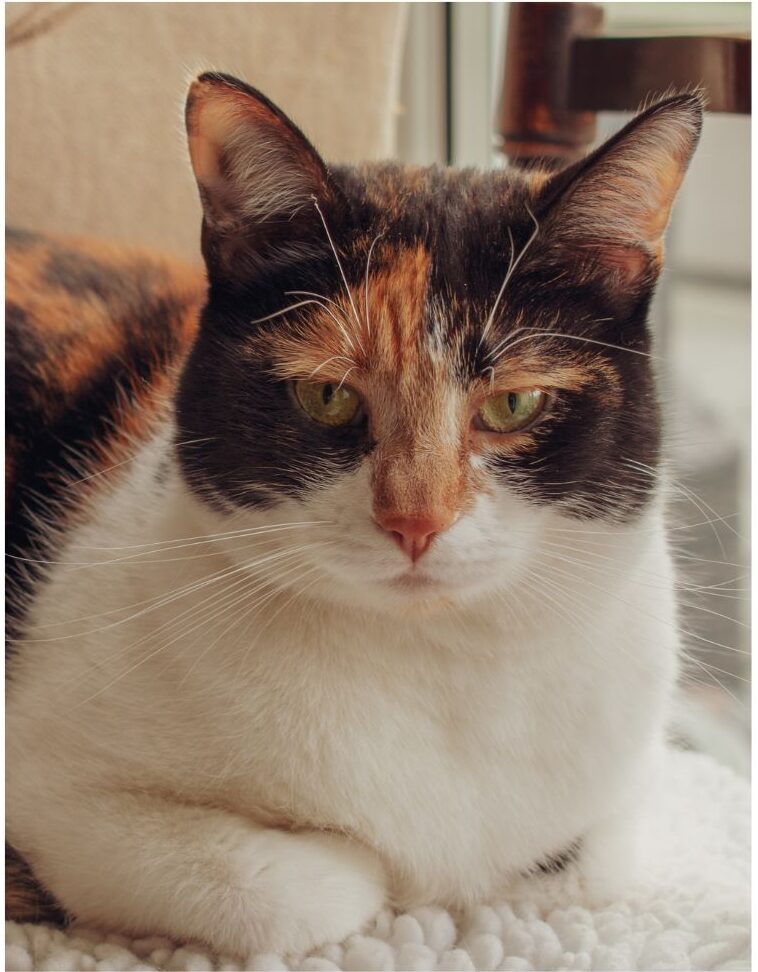
As you can see, there are many variations of tri-color cats but you can still count yourself lucky if you run into one! In many cultures tri-color cats are connected with good luck and good fortune, and in the U.S., they are sometimes called “money cats.”
People who have tri-color cats often report that they’re equally sweet and sassy and tortoiseshell cat owners often refer to their feisty side as having “tortitude.” However, since tri-color cats aren’t a breed, research hasn’t been able to confirm that this extra feistiness is a distinct trait related to their coat pattern. That said, if you haven’t taken our “Whats Your Cat Purrsonality” quiz on our Just Fur Fun page, now’s your chance! Discover which cat breed or color pattern best represents you—maybe even find out if you have a bit of tortitude!”
About the Author: Beth Dokolasa is a volunteer for Cat Care Society and serves on the Board of Directors. She is an instructional developer for Natural Grocers and lives in Indian Hills, Colo., with her husband, daughter, and two cats, Techno and Digit.
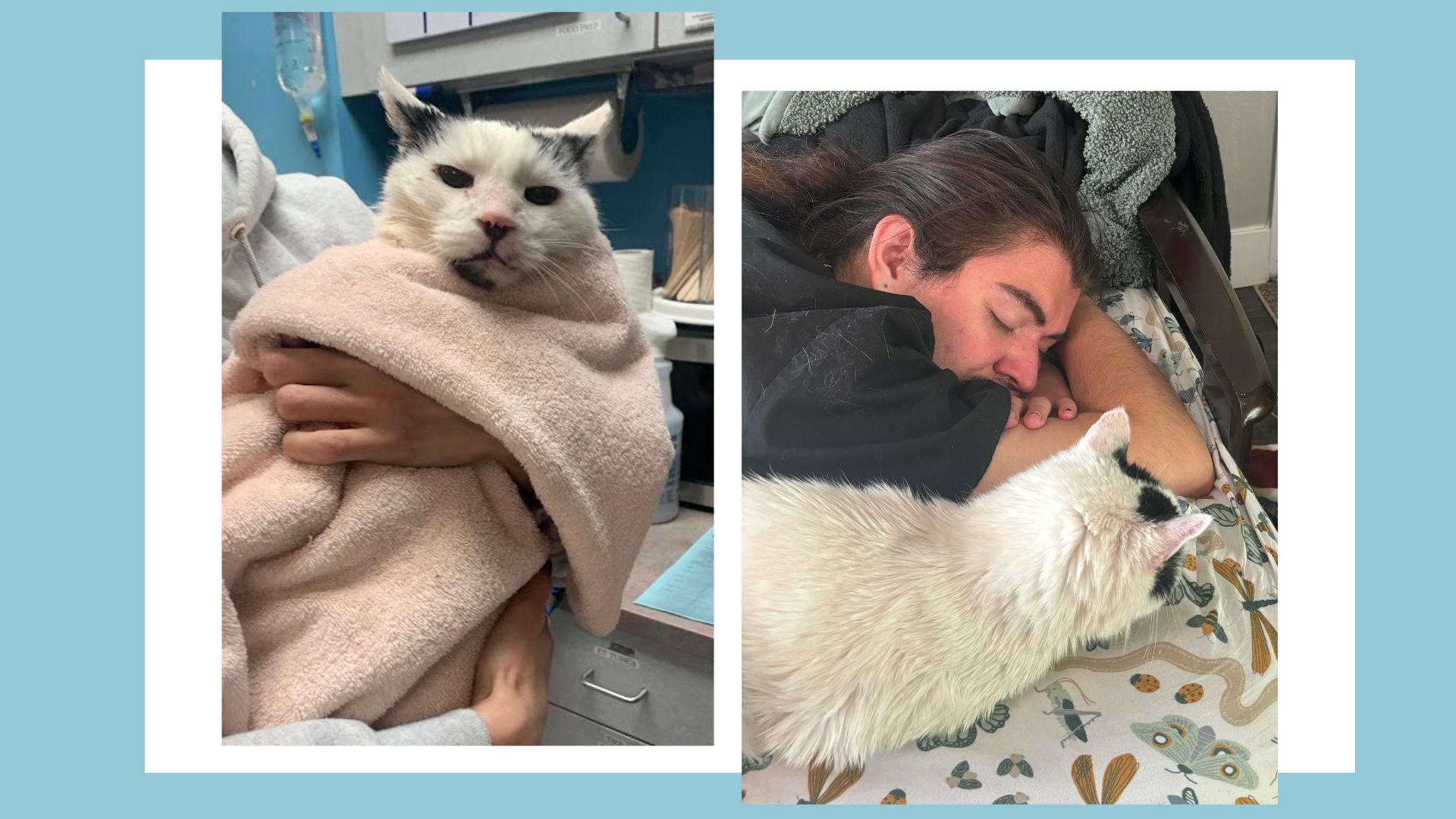
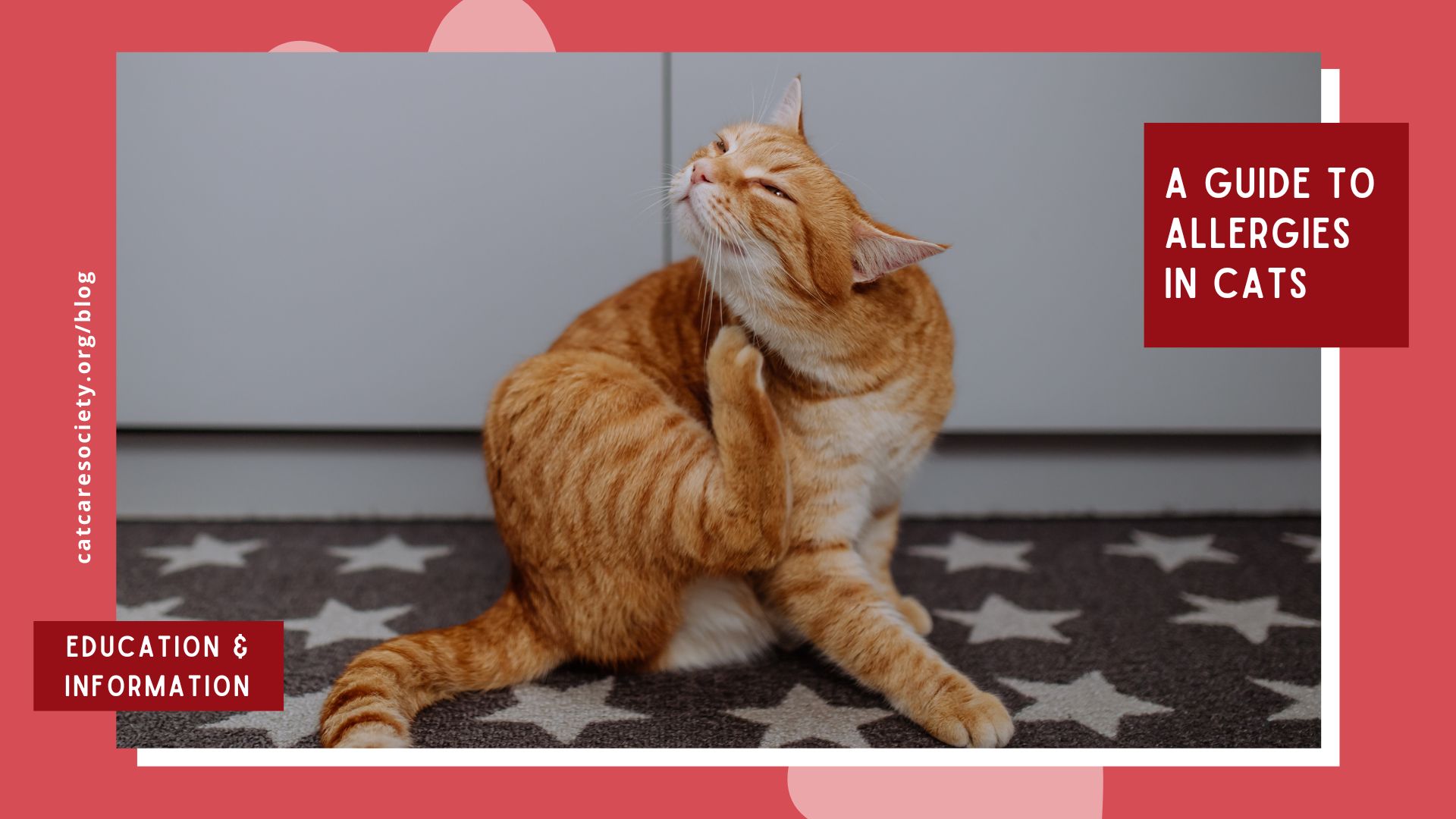
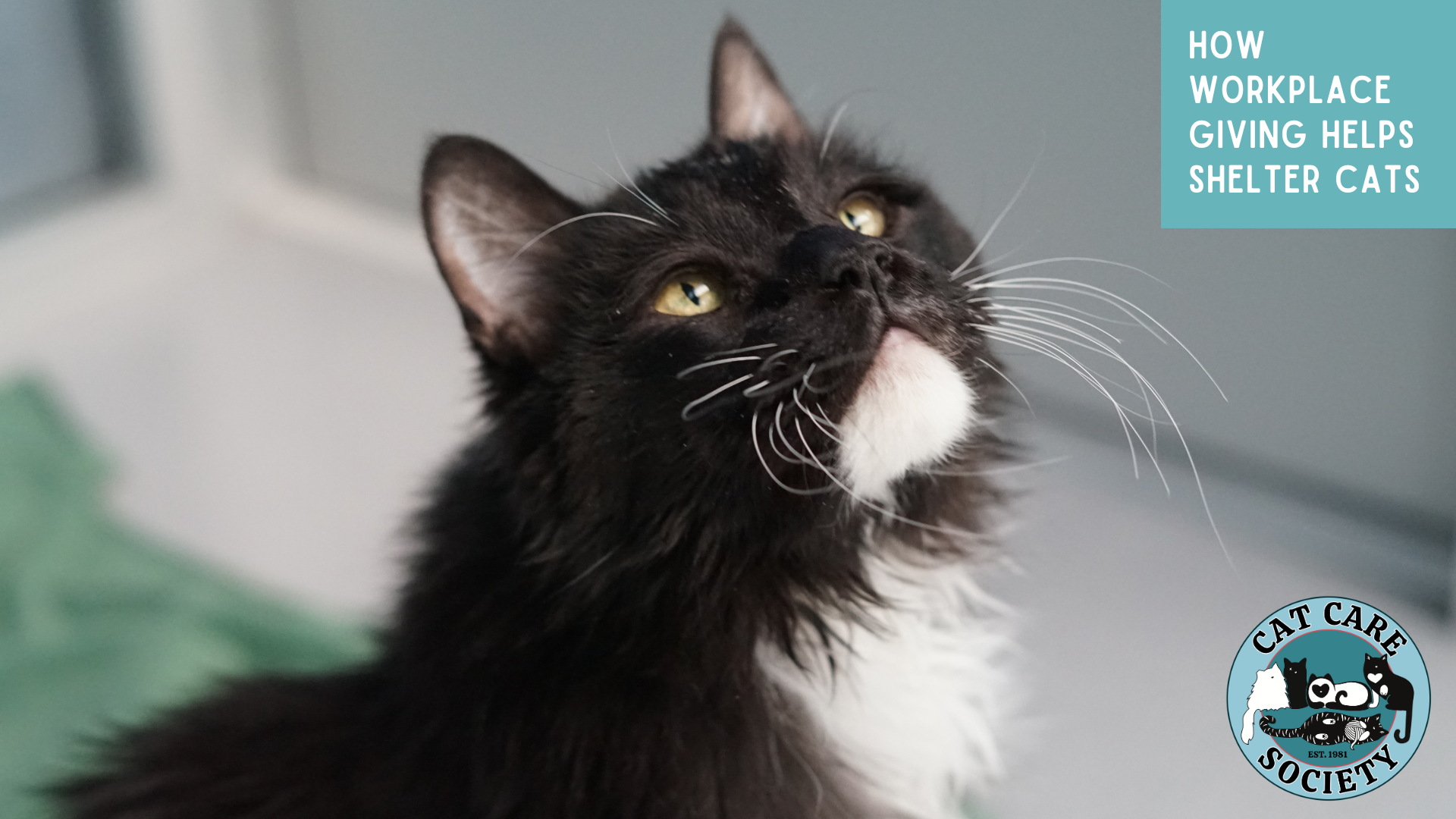

Let’s be honest—if you’re reading this, we probably don’t need to tell you how much joy cats bring into our lives. You already know the comfort of a purring cat in your lap, the entertainment of zoomies, and the simple calm of a cat sunbathing in a window. Cats are family.
But even though they’ve stolen our hearts (and our favorite spots on the couch), there’s still so much we don’t understand about their health. That’s where research comes in—and your participation can help in uncovering the mysteries behind feline wellness.
The health and wellbeing of cats often get overlooked in comparison to other pets like dogs. While research into canine health has flourished over the years, we’re only beginning to scratch the surface (pun intended) when it comes to understanding the unique needs and medical conditions of cats. From chronic illnesses like feline diabetes and kidney disease to behavioral issues such as anxiety and aggression, there are still many unanswered questions about what causes these conditions and how to best treat them.
To improve the lives of cats everywhere, we need more research. By deepening our understanding of how cats experience illness, aging, and stress, we can develop better treatments, prevention strategies, and care—helping them live longer, healthier, and happier lives.
One exciting initiative that aims to fill this gap in feline research is Darwin’s Ark, an online platform started by two pet lovers, a geneticist and an engineer, to advance scientific understanding of pet health. The website is an invaluable resource for anyone passionate about improving the lives of both dogs and cats through data-driven research.
For our purposes, we’re focusing on cat health, and at its core, Darwin’s Ark is about collecting and analyzing data from real cats living in homes, shelters, and other environments. The goal is to create a comprehensive database that researchers can use to study genetic and environmental factors that influence cat health. By gathering data on everything from a cat’s breed and genetic makeup to its medical history and behaviors, Darwin’s Ark provides vital insights that can shape future research.
The beauty of Darwin’s Ark is that it allows cat owners and shelters alike to play an active role in research. By participating in the program, you’re contributing valuable information that could lead to breakthroughs in veterinary science. Here’s how you can get involved:
The research conducted through Darwin’s Ark has the potential to change the way we think about feline health. By looking at the genetic and environmental factors that influence cats’ lives, researchers can gain a better understanding of how diseases like cancer, heart disease, and even infectious illnesses develop in cats. This information will help veterinarians make more accurate diagnoses, prescribe better treatments, and ultimately improve the lives of cats.
But it’s not just about medical conditions. Research into feline behavior and mental health is equally important. Many cats suffer from anxiety, depression, or stress, often due to changes in their environment, lack of stimulation, or inadequate socialization. By understanding the root causes of these behavioral issues, we can develop strategies to create happier, more well-adjusted cats who can thrive in their homes.
Additionally, shelters can use the findings from these studies to provide better care for cats in their care. Whether it’s understanding how to better treat sick cats, providing more enrichment opportunities, or improving the adoption process, data-driven research will help shelters give cats the best possible chance at a healthy and fulfilling life.
In the grand scheme of things, supporting research into feline health is about more than just helping individual cats—it’s about ensuring that all cats, everywhere, can live longer, healthier lives. The more we know, the better we can protect and care for our kitty companions, whether they’re our beloved pets at home or shelter cats.
For more information or to get started, visit Darwin’s Ark today and be sure to check out their fascinating blog article on why cats are so understudied. By supporting platforms like Darwin’s Ark, we take a step toward making a tangible difference in the lives of cats, promoting better health outcomes, and advancing our understanding of these extraordinary animals. Every small contribution counts—whether it’s participating in research, sharing the word, or making a donation. Let’s work together to ensure that all cats can live their best lives.
About the Author: Beth Dokolasa is a volunteer for Cat Care Society and serves on the Board of Directors. She is an instructional developer for Natural Grocers and lives in Indian Hills, Colo., with her husband, daughter, and two cats, Techno and Digit.

If you love cats, you may have heard the term “kitten season” before—but what exactly does it mean? Kitten season is the time of year when shelters and rescues typically receive an influx of newborn kitten litters as well as their mothers. This surge in cats can create challenges for pet shelters, but with the right knowledge and support, everyone can play a part in helping shelters, ensuring the well-being of the cats, and finding them a loving home.
Kitten season typically occurs from early spring through late fall, with a peak in the warmer months. During this time, unspayed female cats go into heat more frequently and have the potential to give birth to multiple litters, with an average of 4-6 kittens born per litter. This can really add up! Many of these kittens are born outdoors to feral or stray cats and end up in shelters or on the streets.
While kittens are undeniably adorable, the large number arriving at shelters during kitten season creates a high demand for resources like medical care, food, and space. In Colorado, kittens cannot be adopted until they are two months old so shelters are providing lots of long term care for them! Shelters and rescue organizations work tirelessly to care for these kittens and their mothers, but they often face challenges like overcrowding and foster home shortages.
Foster homes help address space shortages but they also play a crucial role in keeping all cats healthy. Kittens don’t yet have a fully developed immune system or GI tract making them more vulnerable to catching and spreading illnesses, which can further overwhelm the shelter and impact other cats. Kittens do not begin to receive illness preventing vaccines until they are at least four weeks of age. Additionally, kittens require frequent monitoring, socialization, and specialized care, which can be challenging for shelters managing many animals at once. Foster caregivers help by providing individualized attention, ensuring kittens receive the care they need to grow strong and healthy before adoption.
To reduce the number of kittens in shelters and ease the ongoing pressure on resources, shelters also focus on spaying mother cats, preventing future litters. This helps break the cycle of overcrowding and ensures that shelters can better meet the needs of all the cats in their care. With community support—through fostering, adoption, and other forms of assistance—we can give every kitten the best chance at a healthy, happy future.
There are many ways you can make a difference during kitten season. Whether you’re able to adopt, foster, volunteer, or support from afar, every effort counts. Here are some suggestions:

Many shelters and rescues rely on foster homes to care for young kittens
who are too small to be adopted. These kittens need a safe and loving environment where they can grow, socialize, and receive proper medical care. Fostering is a rewarding experience and saves countless lives. Learn more about being a foster with Cat Care Society and apply online.
Preventing unwanted litters starts with responsible pet ownership. Ensure your own cats are spayed or neutered, and encourage friends and family to do the same. We have a resource list of lost-cost clinics that can help make this more accessible. Encourage your friends and family to read more about the benefits of spaying and neutering your cats in one of our other blog posts.
If you’ve been thinking about welcoming a cat into your family, kitten season is an ideal time to adopt. Shelters are overflowing with kittens and adult cats looking for homes. We also suggest adopting two kittens at the same time so they can continue practicing great behavior habits! By adopting, you’re not only giving a cat a second chance but also freeing up space in shelters for other animals in need. Check out our cats available for adoption!
Cat Care Society has a robust in-house cat socialization and enrichment program, and we also have many great resources to help you bond with your new kitty once it’s home and set up an environment where your cat can play, express their natural behaviors, and thrive!
One of the most effective ways to reduce the number of kittens born on the streets is through Trap-Neuter-Return (TNR). This humane approach involves trapping stray and feral cats, having them spayed or neutered, and then returning them to their outdoor colonies where they have adapted to live. TNR helps stabilize cat populations and prevents future litters from being born. Read more about TNR in one of our other blog posts and check out our list of TNR organizations that provide services in the Denver metro area if you’d like to get involved or need support.
Whether or not you can adopt or foster, there are plenty of ways to make a difference! Here are just a few ways you can help:
EduCATion is key to supporting our cat population—it’s built right into the word! Share information about kitten season, TNR programs, and responsible pet ownership with your community. Social media, local events, and word-of-mouth can all help raise awareness and encourage others to get involved.
Follow us on Instagram, Facebook, and TikTok for helpful, shareable content. Sign up for our email newsletter, aka our Mewsletter, to stay updated on upcoming events, adoptable cats, must-read stories, and ways to support the shelter. We also publish a quarterly print newsletter called Cat Care Quarterly that you can sign up to receive at home for free!

Kitten season is a challenging time for shelters and rescues, but with community involvement, we can help save lives and reduce the number of homeless cats and overcrowded shelters. Whether you open your home to a cat in need, contribute supplies or funds, or simply spread the word, your support makes a meaningful impact. CCS is grateful to all of our supporters, including our dedicated volunteers, fosters, donors, adopters and beyond. Let’s continue working together to give kittens the best start in life and create a brighter, more hopeful future for all cats!
About the Author: Beth Dokolasa is a volunteer for Cat Care Society and served on the organization’s junior board. She is an instructional developer for Natural Grocers and lives in Indian Hills, Colo., with her husband, daughter, and two cats, Techno and Digit.



In Colorado, caring for animals isn’t just a calling—it’s a fundamental responsibility governed by the Pet Animal Care Facilities Act (PACFA). Established in 1994, this program protects the health, safety, and welfare of animals in pet care facilities while also protecting consumers who utilize pet-related services.
Whether someone runs an animal shelter (like we do at Cat Care Society!), a pet grooming business, a breeding operation, or a rescue, PACFA requires a license to legally care for animals. This state law sets comprehensive standards to ensure that animals in licensed facilities receive proper care. Through regular updates and inspections, PACFA prioritizes animal welfare, positioning Colorado as a leader in this field. In this article, we’ll explore the broad and comprehensive scope of PACFA, clarify what it doesn’t cover, and explain why it matters for pets and pet owners across Colorado.

PACFA is Colorado’s state law that regulates companion animal care facilities, ensuring animals receive proper treatment and live in environments where their physical and emotional needs are met. Some animals covered under PACFA include cats, dogs, birds, guinea pigs, mice, rats, hamsters, gerbils, ferrets, rabbits, reptiles, amphibians, and fish.
One of the strongest aspects of PACFA is its comprehensiveness and level of detail. Below are just some of the areas it covers. Note that requirements are individualized based on animal type.
The Colorado Department of Agriculture (CDA) is responsible for enforcing PACFA regulations. This oversight ensures that any organization involved in pet care operates with transparency, accountability, and a deep commitment to the animals in their charge. To earn and maintain a PACFA license, facilities like shelters, rescues, pet stores, and groomers must pass rigorous inspections, meet specific criteria on an ongoing basis, and complete annual reporting.
PACFA’s licensing program isn’t just about paperwork—it’s about safeguarding animal welfare. By maintaining a PACFA license, facilities commit to meeting essential standards for animal housing, health, and safety, all under the enforcement of the CDA. And as these standards are regularly updated, shelters and rescues must stay current, adapting to new regulations that reflect the evolving practices in animal care. Additionally, current PACFA licensees must complete a qualifying continued education every two years to stay up-to-date with PACFA’s standards.
While the terms shelter, rescue, and sanctuary are often used interchangeably, the Colorado Department of Agriculture provides distinct legal definitions for each. The Rules and Regulations Pertaining to the Administration and Enforcement of the Pet Animal Care and Facilities Act (8 CCR 1201-11) specify the classifications for various types of animal facilities. At Cat Care Society (CCS), we operate as a private non-profit animal shelter and do not receive any government funding.
PACFA isn’t animal control or animal protection. Municipal animal control units enforce municipal and state ordinances typically related to private citizen pet ownership, such as dog licensing, leash laws, lost and found, and cruelty/neglect. However, PACFA staff may partner with a local animal control unit if animal cruelty and neglect is discovered.
Additionally, PACFA is required by the state to report animal cruelty and neglect to local law enforcement or the Colorado Bureau of Animal Protection (BAP). BAP conducts outreach and education to prevent neglect and mistreatment of domestic and companion animals in Colorado and follow-up on complaints to help enforce pertinent laws.
PACFA doesn’t oversee licensure of veterinarians or vet techs. The State Board of Veterinary Medicine within Colorado’s Department of Regulatory Medicine regulates and licenses/registers veterinarians and veterinary technicians in the State of Colorado.
Since 1981 Cat Care Society has been committed to a very simple mission: provide cats with the best possible care until they find their forever homes. We fully comply with PACFA’s standards, and our commitment to evolving with the research behind these regulations reflects our ongoing dedication to providing the best possible care for the cats we serve. But we don’t stop there. We believe every cat deserves a safe, loving environment, regardless of age or medical condition.
From individualized care plans to behavioral enrichment programs and our exceptional volunteer and foster teams, we strive to exceed PACFA’s requirements to make sure each cat is living its best life. That includes having a free-roaming environment for our cats and going above and beyond in evaluating older and special-needs cats to determine the best course of treatment and care.

PACFA isn’t just about enforcing rules—it’s about creating a culture of responsibility and compassion across the entire pet care field. By ensuring that everyone in the business of caring for animals meets high standards, PACFA guarantees that every cherished pet gets the attention, safety, and love they deserve.
And at Cat Care Society, we’re all about love—our love for cats and our dedication to upholding the values that PACFA instills. Together, with PACFA’s guidance, we’ll continue to make Colorado a better, safer place for animals, one purr at a time.
We want all animals to be treated with respect and care which is why we encourage you to reference the PACFA Active Facilities List when selecting a pet care service. The CDA also provides detailed information on their website including data, FAQs, and of course, the full PACFA legislation. Here at CCS, we’re committed to transparency, so on our About Us page, you can find details about how we care for our cats, our latest impact report, our strategic plan, and much more! We also offer an extensive list of recommended pet service providers on our Resources page.
About the Author: Beth Dokolasa is a volunteer for Cat Care Society and serves on the Board of Directors. She is an instructional developer for Natural Grocers and lives in Indian Hills, Colo., with her husband, daughter, and two cats, Techno and Digit.

Winter, with its short days and chilly weather, often confines us indoors, making it the perfect season to enjoy the warmth and company of a cat. A field of study known as zooeyia (pronounced zoo-AY-uh) explores the positive impact of human-animal interactions on health, including physical, mental and emotional health. Meaning a cat isn’t just comforting a cozy companion during the colder months, but you share a beneficial, lifelong bond. In this article, we’ll explore the many health benefits to sharing your home with a cat. We’ll also provide some fun activities to enjoy with your cat during a cozy snow day.
Derived from the Greek word for “animal” (zoion) and “health” (Hygeia, the ancient Greek goddess of health), zooeyia encompasses the wide-ranging physical, emotional, and social benefits of owning pets. Cats, as beloved companions, exemplify zooeyia by their ability to:
Combat winter monotony by getting creative with your cat! These activities not only enrich your pet’s life but also elevate your mood and strengthen the bond between you and your kitty.


Note that some cats need breaks from physical touch. Read our blog post on overstimulation in cats to learn how to recognize the signs to ensure a positive experience.
Cats offer much more than companionship—they embody the principles of zooeyia by enhancing our mental and physical health, especially in challenging times like winter. Pairing these benefits with fun activities ensures both you and your cat stay happy and engaged. We always have cats available for adoption, so check them out if you’re ready to embrace the warmth and joy they bring to your home (or multiply it if you already have cats!).
About the Author: Beth Dokolasa is a volunteer for Cat Care Society and serves on the Board of Directors. She is an instructional developer for Natural Grocers and lives in Indian Hills, Colo., with her husband, daughter, and two cats, Techno and Digit.
Resources
Allen, K., Blascovich, J., & Mendes, W. (1998). Cardiovascular reactivity and the presence of pets, friends, and spouses: the truth about cats and dogs. International Journal of Psychophysiology, 30(1–2), 116. https://doi.org/10.1016/s0167-8760(98)90295-1
Anderson, K. L., & Olson, J. M. (2015). The value of a pet in enhancing the quality of life. The Journal of the American Board of Family Medicine, 28(4), 526–534. https://www.jabfm.org/content/28/4/526.long
McConnell, A. R., Brown, C. M., Shoda, T. M., Stayton, L. E., & Martin, C. E. (2011). Friends with benefits: On the positive consequences of pet ownership. Journal of Personality and Social Psychology, 101(6), 1239-1252. https://doi.org/10.1037/a0024506
Stammbach, K. B., & Turner, D. C. (1999). Understanding the Human—Cat Relationship: Human Social Support or Attachment. Anthrozoös, 12(3), 162–168. https://doi.org/10.2752/089279399787000237

With Halloween approaching, it’s the perfect time to spotlight a particular type of cat—and no, we’re not talking about black cats! Instead, we’re focusing on tri-color cats, whose coats feature a mix of black, orange, and white in varying patterns and ratios. While “tri-color” and “calico” are often used interchangeably, calico cats have a distinct coat pattern. Tortoiseshell cats are also considered tri-color, even though they usually lack white and have their own unique pattern. It’s important to remember that “calico” and “tortoiseshell” refer to coat patterns, not breeds. These color combinations are the result of genetics and can appear in any breed, though they are more commonly found in breeds like American Shorthair, British Shorthair, Japanese Bobtail, Maine Coon, and Persian.
There are also diluted and tabby variations of tortoiseshell and calico cats—so many colorful kitties to love! In the rest of this article, we’ll explore the different markings and patterns that define each type of tri-color coat. By the end, you’ll be able to recognize the unique beauty of every tri-color cat you encounter.
Tri-color cats are almost always female, with approximately one in 3,000 being male. This is because two X chromosomes are needed to have a distinctive tri-color coat. Typically, if a cat has an XX pair, she will be female. Male cats have an XY chromosome pair, so they’re not tri-color unless they have at least one extra chromosome (XXY). Unfortunately, these males often suffer from Klinefelter’s Syndrome, a condition that can negatively affect their health and longevity.
Calico cat coats feature patches of solid orange, black, and white. The white color is a result of a genetic condition called piebalding, which occurs in a range of other domestic and farm animals. In a diluted calico, the colors are more muted to cream, gray, and white, due to a gene inherited from one of the parents that diminishes color intensity.

“Tabico” is a term for cats that have a combination of tabby and calico markings. These cats have large patches of orange and black on a white background, with tabby stripes overlaying some of the black and orange areas. When tabby stripes cover the forehead, they form the distinctive “tabby M.” A diluted tabico’s coat features cream, gray, and white fur.

Tortoiseshell, or “tortie,” cats have brindle patterns (irregular stripes or streaks) of orange and black with little to no white. A diluted tortie has gray and cream colors and is a result of both parents carrying a recessive gene that impacts the intensity of the colors.

A torbie cat exhibits both the multi-colored brindle pattern of a tortoiseshell cat and the characteristic stripes or spots of a tabby. Like the tabico, if there are tabby stripes on the cat’s forehead, they will display the “tabby M.” Diluted torbies usually have a cream, gray and white coat.
A “tortico” is a combination of classic tortie and calico markings, featuring large patches of orange and black brindling on a white background. A diluted tortico is relatively rare, and will be gray and cream, and white.

As you can see, there are many variations of tri-color cats but you can still count yourself lucky if you run into one! In many cultures tri-color cats are connected with good luck and good fortune, and in the U.S., they are sometimes called “money cats.”
People who have tri-color cats often report that they’re equally sweet and sassy and tortoiseshell cat owners often refer to their feisty side as having “tortitude.” However, since tri-color cats aren’t a breed, research hasn’t been able to confirm that this extra feistiness is a distinct trait related to their coat pattern. That said, if you haven’t taken our “Whats Your Cat Purrsonality” quiz on our Just Fur Fun page, now’s your chance! Discover which cat breed or color pattern best represents you—maybe even find out if you have a bit of tortitude!”
About the Author: Beth Dokolasa is a volunteer for Cat Care Society and serves on the Board of Directors. She is an instructional developer for Natural Grocers and lives in Indian Hills, Colo., with her husband, daughter, and two cats, Techno and Digit.



Please include your full name on a gift note when sending donations through Amazon or Chewy, so we can properly acknowledge your generous contribution! Without it, we won’t be able to identify that the items are from you. Also, please keep your shopping receipt, as it serves as your official donation receipt.
Copyright © 2024-2025 Cat Care Society. All Rights Reserved. | Privacy Policy
The Cat Care Society is a non-profit 501(c)(3) organization. Our tax identification number is 84-0869447.